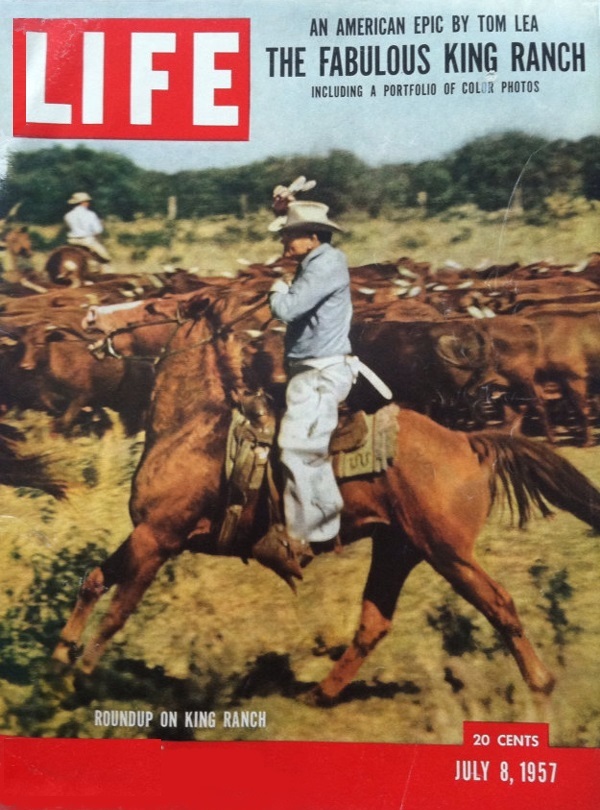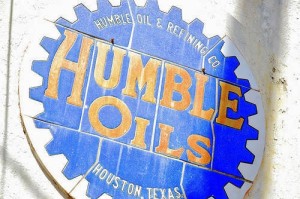America’s largest ranch signed a record-setting oil lease in 1933, launching a major oil company.
The largest U.S. private oil lease ever negotiated was signed in Texas during the Great Depression. The 825,000 acre King Ranch oil deal with Humble Oil and Refining, signed on September 26, 1933, would help the company become ExxonMobil, which has extended the agreement ever since.
At its peak covering one million acres, the King Ranch has remained bigger than the state of Rhode Island (776,960 acres). Despite unsuccessful wells drilled on the south Texas ranch for more than a decade, a Humble Oil geologist was convinced an oilfield could be found.

LIFE magazine’s July 8, 1957, issue with its “Roundup on King Ranch” cover photo, included interviews with Robert Kleberg, who earned hundreds of millions of dollars in royalties from his grandfather’s 1933 lease deal.
America’s largest ranch began in 1852, when Richard King and Gideon Lewis established a cattle camp on Santa Gertrudis Creek southwest of Corpus Christi, according to the Texas State Historical Association. The King Ranch began expanding into multiple counties, including Nueces, Kenedy, Kleberg, and Willacy.
The King Ranch’s distinctive “Running W” brand, registered in 1869, is said to represent a moving rattlesnake, the horns of a Texas Longhorn, or the curves of Santa Gertrudis Creek.
As the ranch became famous for its longhorn cattle, petroleum exploration there began as early as 1919. All of the exploratory wells seeking oil — drilled by the future largest U.S. oil company — were expensive “dry holes.”
Humble Beginnings
Humble Oil and Refining Company, a Houston-based company founded in 1917, had found no King Ranch oil by 1926, and the company let its lease expire. New exploration and production terms needed to be negotiated.
“Agreement was not reached until 1933, because Humble’s top management was uncertain about the oil potential of this part of Texas,” explained a 1976 article by John Ashton and Edgar Sneed.
Company geologist Wallace Pratt finally convinced Humble Oil and Refining President W.S. Parrish to lease the King Ranch for $127,824 per year, plus a one-eighth royalty.

Humble Oil and Refining Company’s first home office was built in 1920 at Main and Polk streets in downtown Houston.
The petroleum lease, signed on September 26, 1933, would bring wealth to both the ranch and the young petroleum company. Subsequent leases from neighboring ranches gave Humble Oil and Refining nearly two million acres of mineral rights between Corpus Christi and the Rio Grande River.
Although King Ranch completed a successful oil well in 1939, drilling new wells lagged until 1945 and discovery of the Borregas oilfield.
“After that, several major oil and gas discoveries were made on the ranch, where in 1947 Humble operated 390 producing oil wells,” noted Ashton and Sneed in their Handbook of Texas Online article, “King Ranch.” Humble Oil constructed a refinery in Kingsville to process the growing oil production in South Texas.
Destined for Greatness
King Ranch had 650 producing oil and natural gas wells in 1953. In 1980, a subsidiary — King Ranch Oil and Gas — was formed to conduct exploration and production in five states and the Gulf of Mexico. Eight years later, the company sold its Louisiana and Oklahoma holdings to Presidio Oil Company for more than $40 million.
“In 1992 King Ranch Oil and Gas was one among several companies to discover natural gas off the coast of Louisiana,” concluded Ashton and Sneed. By 1994, the ranch had received petroleum royalties amounting to more than $1 billion since World War II, the Handbook of Texas authors estimated.

A postcard of the tiered Mediterranean-style main house of King Ranch headquarters in Kingsville, Texas, that “looms like a palace over the kingdom.”
In 1933, Humble Oil and Refining Company consolidated its operations with Standard Oil of New Jersey. A decade later, the company completed the first Florida oil well.
By the 1950s, a merger of operations with Esso, led to Exxon. After evolving into ExxonMobil, the King Ranch lease agreement continued to be extended — in effect since September 1933. “The King family became the closest thing to royalty in Texas,” Nanette Watson proclaimed in her April 2012 article in Houses with History.
“Admired for their hard work and generosity, the family is expressly private and protective of their land,” she reported. “The ruling family’s tiered Mediterranean-style main house at the headquarters looms like a palace over the kingdom.”
Watson added the family’s “destined for greatness” legacy inspired it being portrayed in the 1956 Hollywood movie Giant, starring Elizabeth Taylor, James Dean, and Rock Hudson. Despite rancher (Hudson) and driller (Dean) in conflict leading up to a climatic oil gusher, effective well-control technologies had been around for more than 30 years by the time the film was made.
_______________________
Recommended Reading: Kings of Texas: The 150-Year Saga of an American Ranching Empire (2003). Your Amazon purchase benefits the American Oil & Gas Historical Society. As an Amazon Associate, AOGHS earns a commission from qualifying purchases.
_______________________
The American Oil & Gas Historical Society (AOGHS) preserves U.S. petroleum history. Please become an AOGHS annual supporter and help maintain this energy education website and expand historical research. For more information, contact bawells@aoghs.org. Copyright © 2024 Bruce A. Wells. All rights reserved.
Citation Information – Article Title: “Oil Reigns at King Ranch.” Authors: B.A. Wells and K.L. Wells. Website Name: American Oil & Gas Historical Society. URL: https://aoghs.org/oil-almanac/king-ranch-oil. Last Updated: September 19, 2024. Original Published Date: April 29, 2014.



